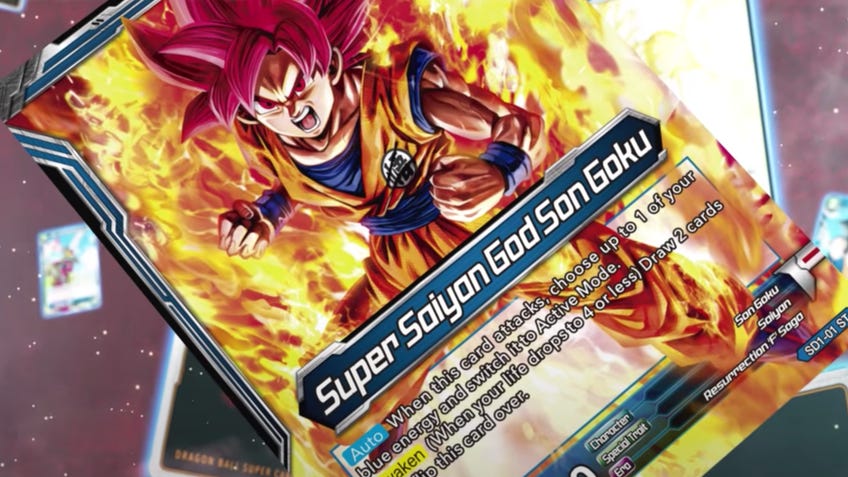How to play Dragon Ball Super Card Game: TCG’s rules, how to build a deck and how to win explained
Kamehame-card!
The Dragon Ball Card Game brings the hard-hitting action of the anime series to a trading card game. While the numbers may be well over 9,000 and there’s plenty of text on almost every card, learning how to play the Dragon Ball Card Game is fortunately a bit less intimidating than it seems.
At its heart, the Dragon Ball Card Game looks to recreate the incredible fights seen in the massively popular manga and TV show to the tabletop. Familiar faces such as Goku, Vegeta, Frieza, Beerus and Trunks can do battle by leading a deck full of allies and abilities, dishing out huge amounts of damage with massive attacks as they try to bring their opponent’s life down to zero.
How to play Dragon Ball Super Card Game
- What is the Dragon Ball Super Card Game?
- How to build a deck
- Setup
- Rules
- How to win
- Keywords explained
- Can you play the Dragon Ball Super Card Game with more than two players?
To perform those powerful moves, you’ll need to charge up your energy - as anyone who’s watched Dragon Ball before will know. As you play cards to your energy area and use them to activate characters and abilities, as well as the skills of your leader, you’ll be looking to take on your opponent’s own leader and amass enough power to knock down their life.
While there are lots of keywords with unique effects, which can make things seem more complicated, learning how to play the Dragon Ball Card Game is actually fairly straightforward. If you’ve played Magic: The Gathering or Pokémon before, there’ll be plenty here that will quickly feel familiar - with some fun new twists that bring the flashy action of Dragon Ball alive.
So read on to learn the rules of Dragon Ball Super Card Game, along with how to build your first deck and claim victory against your opponent. Just be careful not to destroy the Earth (or any other planet!) while you’re at it.
What is the Dragon Ball Super Card Game?
The Dragon Ball Super Card Game is a two-player trading card game based on the popular manga and anime series Dragon Ball Super. Dragon Ball Super is part of the long-running Dragon Ball series created by Akira Toriyama, following the adventures of Saiyan hero Son Goku and his companions as they defend the Earth from alien villains and seek out the Dragon Balls to have their wishes granted.
In the Dragon Ball Super Card Game, players take turns playing cards from their hand to battle their opponent’s characters, aiming to reduce their life to zero first. Each player’s deck is led by a leader - a familiar character from Dragon Ball Super, such as Goku, Vegeta or Trunks - who can charge their energy to unleash more powerful attacks and abilities.
How to build a Dragon Ball Super Card Game deck
Your Dragon Ball Super Card Game deck must include one leader card and a main deck made up of between 50 and 60 cards. (Some demo decks may have fewer cards.) The cards in your deck must be Battle cards, Extra cards or Unison cards.
Your leader doesn’t count as part of your deck, as it sits outside of your deck on the table. Essentially, it represents your character in the game, while the deck represents your allies and abilities - similar to Magic: The Gathering’s popular Commander format.
You can only have up to four copies of a single card in your deck. Individual cards are identified by the card number written in the bottom-right corner of the card.
In addition to your main deck, you can also have a side deck known as a Z-Deck. This can include up to seven Z-Cards, which have the “z” card type. Like your main deck, you may only have up to four copies of the same Z-Card in your Z-Deck.
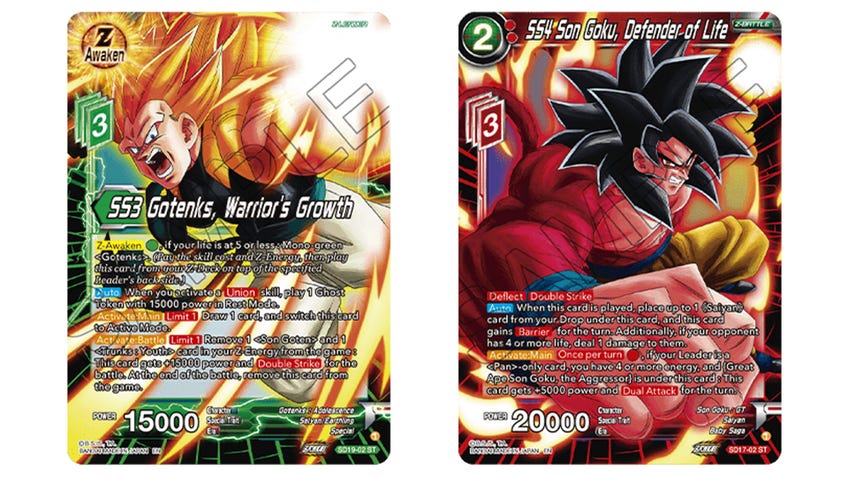
Dragon Ball Super Card Game setup
- To set up the Dragon Ball Super Card Game, first place your leader card in your leader area. Your field consists of three rows; your leader area is on the centre-left of the top row. Your leader card starts face-up in active position, indicated by being orientated upright.
- Shuffle your deck and place it facedown on the deck area. This is on the very right-hand side of the middle row. You cannot look at your deck or change its order. Below your deck is the drop area, which acts like a discard pile. Cards are placed face-up into the drop area, and cards in the drop area can be freely looked at by either player.
- If you’re using a Z-Deck, place it facedown to the left of your leader. You may look at and change the order of your Z-Deck at any time. (But you can’t look at your opponent’s Z-Deck.) To the left of the Z-Deck is the Z-Energy area, where Z-Energy will be placed face-up when played.
- Determine a first player. The official Dragon Ball Super Card Game rules recommend using a random method such as rolling a die. The winner goes first.
- Both players should draw six cards from their deck to form their starting hand. Each player may mulligan once by returning any number of cards to their deck before shuffling the deck and re-drawing the same number.
- Place eight cards from the top of your deck into your life area facedown, without looking at them. Your life area is on the left-hand side of your playing field, underneath your Z-Energy Area. These cards serve as your life total; the first player to run out of life, loses.
- With setup complete, you’re ready to play the Dragon Ball Super Card Game.

Dragon Ball Super Card Game rules
There are three phases during your turn in the Dragon Ball Super Card Game:
- Charge Phase
- Main Phase
- End Phase
1. Charge Phase
During your Charge Phase, you reset your rested cards to active mode, draw a card and choose whether add a card from your hand to your energy area.
First, turn any rested cards - indicated by being turned sideways, like tapping in Magic: The Gathering - to active mode by placing them upright.
Then, draw a card from your deck. The first player skips this step on their first turn. Players can hold any number of cards in their hand; there is no hand limit in the Dragon Ball Super Card Game.
Finally, you may add a card from your hand to your energy area on the table. This is optional. Cards in your energy area are used to pay for other cards and skills, much like lands in Magic: The Gathering. You can have any number of cards in your Energy Area.
2. Main Phase
During the main phase of their turn, there are four different actions that players can perform. They can perform any of these actions as many times as they like, in any order:
- Play Battle cards
- Play a Unison card
- Use card skills
- Battle
Play Battle cards
To play a Battle card from your hand, you must pay energy from your energy area equal to the card’s cost, found in the top-left corner of each card. To pay energy, rest cards in your energy area by turning them 90 degrees sideways.
Some cards may require energy of a specific colour, indicated by a number of coloured dots along the edge of their cost value. You must pay at least that number of energy of the matching colour, with the rest of the card’s cost paid using energy of any colour. For example, a card with a total cost of 8 and 5 red dots would require 5 red energy and 3 remaining energy of any colour to be rested.
Once a card’s cost has been paid, add it to your battle area. Your battle area is in the top row of your field, to the right of your leader. (Leave a one-card space for your unison area.)
Z-Battle cards are played from your Z-Deck by spending a combination of normal energy and Z-Energy from your Z-Energy area, as specified by the card. When Z-Energy is spent, it is discarded to the drop area. You can choose to play any Z-Battle card from your Z-Deck during your main phase, treating it like an extension of your hand.
Any number of battle cards can be played to your battle area, and any number can be played on the same turn as long as you have enough energy to pay for them.
Play a Unison card
Like battle cards, Unison cards are played from your hand by paying their cost in energy. This cost can include a specific number of energy of a specific colour - indicated by coloured dots along the edge of the circle - plus an X value. Once they have paid the specified cost in specific energy, the player may choose to rest any number of energy cards - including 0 - to count as the X value.
When you have paid for the card, play it to the Unison area. The Unison area is between your leader card and battle area. Only one Unison card may be in the Unison area at any time; if you play a new Unison card, discard the previous one to your drop area.
When a Unison card is played, add tokens to it equal to the amount of X energy paid. These tokens may be removed later to activate the card’s abilities, as stated in its text.
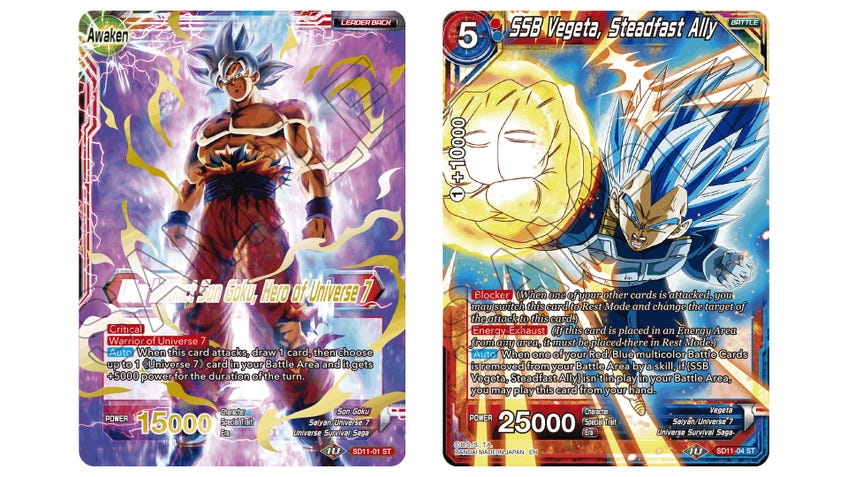
Use card skills
Cards that have the keyword Activate:Main can use their abilities during the main phase. Leader, battle and Unison cards must be on the field to be activated, while Extra cards may be used from your hand.
Some skills require an energy cost, which is paid by resting that amount of energy cards in your energy area. This may include a specific number of cards in a certain energy colour.
To play a Z-Leader from your Z-Deck using the Z-Awaken ability, pay the specified cost in energy and Z-Energy. Z-Energy is discarded to the drop area when spent. Using Z-Awaken allows a Z-Leader to replace your current leader; place the card on top of your previous leader card. If the Z-Leader is removed from the game, your previous leader returns.
Extra cards are discarded to your drop area after they are activated. Some Extra cards have the keyword Field, which means they are instead placed in the battle area in active mode.
Abilities that can be activated during the main phase include Evolve, EX-Evolve, Xeno-Evolve, Union, Over Realm, Dark Over Realm, Swap, Awaken, Awaken:Surge, Wish and Z-Awaken. The Z-Awaken ability can only be used once per turn.
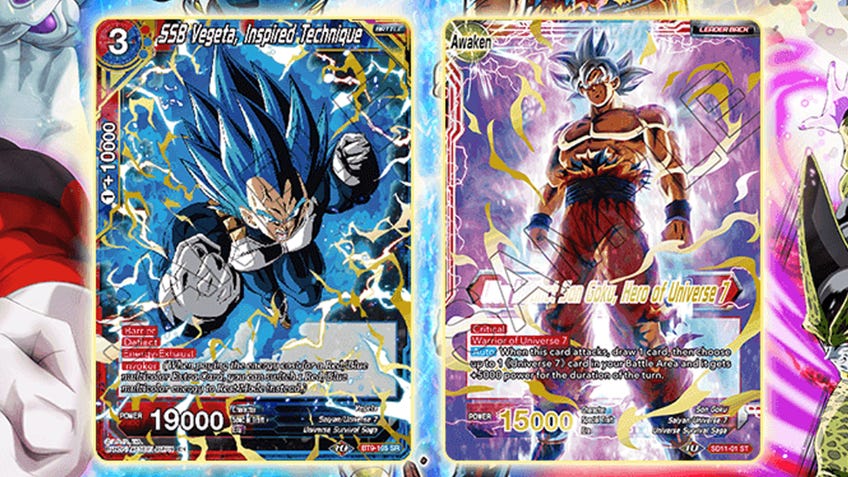
Battle
To battle your opponent, rest your leader card, a battle card or your union card. (they must be active to be rested.) Unlike games such as Magic: The Gathering, cards can attack on the same turn they are played. However, the first player can’t attack during their first turn.
Once you have chosen the card you want to attack with, select a target: your opponent’s leader, one of their rested battle cards or their unison card if it’s rested. Battle and unison cards must be rested in order to be targeted by an attack.
Once an attacker and target have been selected, battles play out in three steps: Offense, Defense and Damage.
1. Offense Step
During the offense step, you - as the attacking player - can boost your attack power by comboing cards and activate card skills.
To combo, add battle cards from your hand or active cards in your battle area to the combo area by paying their combo cost. A card’s combo cost can be found on the left-hand edge of the card, under its normal energy cost. This cost is paid like normal, by resting energy in your energy area.
The combo area is the middle row of your field between your energy area and battle area. Any number of cards can be used in a combo as long as you have the energy to pay for them. Cards used in a combo add their power to the attacking and defending cards’ values.
To activate card skills, cards must have the keyword Activate:Battle. These abilities include Awaken, Awaken:Surge and Wish. Leader, battle cards and Unison cards on your field can be activated, as well as Extra cards in your hand.
You can combo and activate card skills as many times as you like in any order during the offense step.
2. Defense Step
The defense step works just like the offense step, except it’s the turn of the defending player to combo and activate card skills. These work exactly the same as they do for the attacker, as explained above, and can be repeated any number of times in any order.
If a unison card is being attacked, the defense step is skipped and the defender doesn’t get a chance to combo or activate abilities.
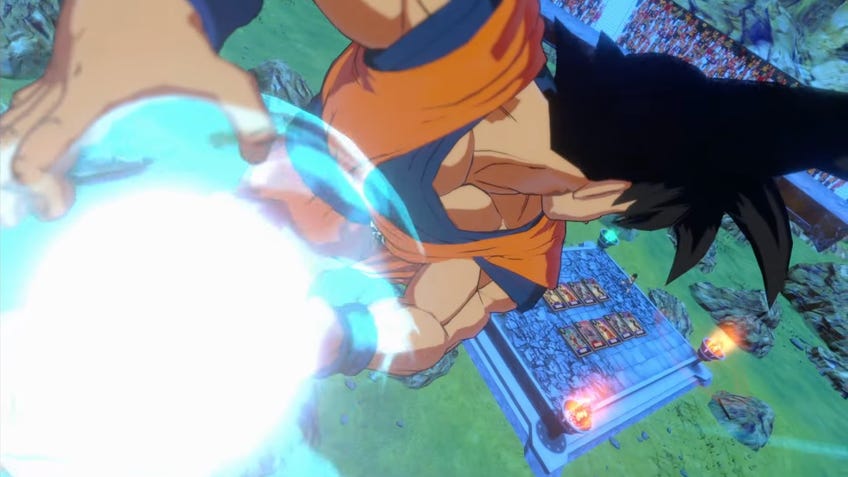
3. Damage Step
During the damage step, the attacker and defender compare the power of their cards to work out if a battle is successful.
To calculate a card’s power, add its power value - as found in the bottom-left corner - and add it to any cards used in a combo. Combo cards add the value written along their left-hand edge.
The higher value wins, with ties going to the attacker.
If the attacker is successful, they damage their opponent:
- If you attacked a leader card, the player takes one point of damage. They choose a facedown card from their life area (without looking!) and add it to their hand.
- If you attacked a rested battle card, the card is KO’d and discarded to the player’s drop area. If a Z-Card is KO’d, it is removed from the game.
- If you attacked a rested unison card, the card loses a token. If a unison card has no more tokens on it, it is discarded to the player’s drop area.
Finally, any cards that were used to combo are discarded from each player’s combo area to their drop area. If you are playing with a Z-Deck, you can add one card from your combo area face-up to your Z-Energy area.
3. End Phase
During the end phase, play passes to your opponent for their turn. Simple as that!
How to win the Dragon Ball Super Card Game
To win the Dragon Ball Super Card Game, you must reduce your opponent’s life to zero. Once they draw their final life card from their life area - for example, after being damaged in a battle - they immediately lose the game.
If a player runs out of cards in their deck, they instantly lose. (An exception is if you’re playing with smaller demo decks, in which case you simply reshuffle your drop area and warp pile into a new deck.)
Dragon Ball Super Card Game keywords explained
- Aegis X/Y: Discard card(s) from your hand to your drop area matching the colours specified by the Aegis skill. For example: Aegis Blue/Red requires one blue and one red card, or a single blue and red card, to be discarded. Once the cost is paid, you may choose up to two rested energy cards and switch them to active. (By turning them 90 degrees upright.)
- Alliance: This ability automatically activates when the card attacks, requiring the specified cards to be rested. (Turned 90 degrees sideways.)
- Arrival: Activated during battle when the specified cards are used in a combo. If the activation conditions are met, the card with Arrival can be played during your offense or defense step.
- Awaken: Can be used during your main phase, offense step or defense step. When the conditions are met, flip over the card. Any power or position changes remain on the card.
- Awaken:Surge: Works exactly the same as Awaken, as explained above, but is found on multicolour leader cards.
- Barrier: Cards with the Barrier keyword can’t be targeted by opposing cards’ skills.
- Blocker: Cards with the Blocker keyword can be rested during an opponent’s attack to change the target of their attack to the Blocker card.
- Bond X: Activates when at least the specified number and type of cards are in your battle area. For example, Bond 2: Namekian requires at least two Namekian cards in your battle area to be activated.
- Burst X: Discard the specified number of cards (eg. Burst 3) from the top of your deck to your drop area to activate.
- Counter:X: Activated when your opponent performs the action specific. For example, Counter:Play is activated in response to your opponent playing a battle card, while Counter:Attack activates in response to an attack. Counter cards are usually discarded to your drop area after use, unless the card states otherwise.
- Critical: When a Critical card successfully damages an opponent in a battle, the opponent must place any life cards in their drop area instead of in their hand.
- Dark Over Realm X: Activated during the main phase if the number of black cards in your drop area pile is equal to or greater than the number specified. (For example, Dark Over Realm 5 required five black cards in your drop area.) To activate, move all your cards from your drop area to your Warp. Over Realm and Dark Over Realm can only be used once in total (between both abilities) per turn.
- Deflect: Cards with the Deflect keyword ignore Counter:Play abilities.
- Double Strike/Triple Strike/Quadruple Strike: On a successful attack on an opponent’s leader, cards with these keywords deal two, three or four damage respectively, instead of the standard one. If a card has multiple Double Strike/Triple Strike/Quadruple Strike keywords, only the one that would deal the most damage is applied.
- Dragon Ball: Up to seven copies of a card with this keyword may be included between your main deck and side deck.
- Dual Attack/Triple Attack: Cards with these keywords are reset to active mode after attacking once (Dual Attack) or twice (Triple Attack), allowing them to attack two or three times in the same turn.
- Energy-Exhaust: Cards with this keyword must be placed in the energy area in rest mode, rather than the standard active position.
- Evolve/EX-Evolve: Cards with these keywords can be played from your hand during your main phase. Evolve cards are placed on top of the specified card. Any existing power, token or position changes carry over to the evolved card.
- Field: Cards with Field can be activated from your hand and placed in the battle area. Field effects on Extra cards only take effect when placed in the battle area. Only one Field effect can be activate in your battle area; when you activate a new card, discard the previous Field card to your drop area.
- Indestructible: Indestructible cards cannot be KO’d or removed from the battle area by your opponent’s attacks or card skills.
- Invoker: Allows a red/blue multicolour energy card with this keyword to be switched to rest mode instead of paying the energy cost of a red/blue Extra card.
- Offering: Activates automatically when the card is played. Your opponent must choose between placing a card from their life area into their drop area, or allowing you to draw two cards.
- Overlord: Activated during the main phase by placing a battle card with the keyword Servant to the bottom of your deck. When activated, draw a card from your deck.
- Over Realm X: Can only be activated when the number of cards in your drop area is equal to or greater than the number specified by the keyword. Allows you to play the card with the Over Realm keyword by moving all of the cards in your drop area to your Warp. Cards with Over Realm are sent to their player’s Warp at the end of the turn. Over Realm and Dark Over Realm can only be used once in total (between both abilities) per turn.
- Rejuvenate: When activated during your main phase, place a card underneath the card with the Rejuvenate keyword, and place both into your drop area. Then, pay the skill cost to add the top card of your deck into your life area.
- Revenge: When a Revenge card is used as a guard card during battles, it automatically KO’s the attacking card at the end of the battle.
- Revive X/Y: Pay the specified energy cost (for example, Revive Blue/Green would require one blue and one green card, or one blue and green card) to bring back a card with this keyword KO’d in battle. The revived card cannot use its skills for the rest of the turn.
- Servant: Servant cards gain +10,000 power but cannot be switched to active mode during the Charge phase of your turn. They are also used to active Overlord abilities.
- Sparking X: Can only be activated when your drop area has as many as or more cards than specified by the skill. For example, Sparking 4 would require at least four cards in your drop area.
- Successor: Can be activated from your hand. To play a Successor card, choose any number of green, yellow or green/yellow cards, with a total energy cost equal to the energy value of the card with Successor, and place them in their players’ drop areas.
- Super Combo: You may only have a total of four cards with the Super Combo keyword in your deck.
- Swap X: Activated from the battle area during your main phase. Pay the specified cost to play one of the cards named by the skill from your hand, then return the card with Swap to its player’s hand.
- Ultimate: You can only have one card with the Ultimate keyword in your deck.
- Unique: Only a single copy of each card with the Unique keyword can be in your battle area.
- Union: A family of skills activated during your main phase, detailed below.
- Union-Potara: Activated from your hand. Stack the specified cards together and place the Union-Potara card on top. The stack is treated as a single battle card, and inherits any power changes from the cards in the stack.
- Union-Fusion: Pay the specified cost and place the named cards in your drop area to play the Union-Fusion card in active mode.
- Union-Absorb: Activated on cards in the battle area. Pay the energy cost and place the specified cards (from areas specified by the skill) underneath the Union-Absorb card. When activated, you can search your deck for a specific card and pay it on top of the Union-Absorb card. The card inherits any changes to power and position from the cards placed underneath it.
- Victory Strike: If a card with Victory Strike makes a successful attack against the opponent’s leader and deals damage, you immediately win the game.
- Warrior of Universe 7: Ignore any specified costs on Universe 7 cards in any area on the field.
- Wish: Can be activated during your main phase, offense step or defense step. Requires seven Dragon Ball cards in your drop area to activate. When activated, flip over the card with the Wish keyword. Its position and any changes to power stay the same.
- Wormhole: Allows Over Realm and Dark Over Realm skills to be activated a total of twice (between the two abilities) per turn.
- Xeno-Evolve: Can be activated from your hand during your main phase. Allows you to play cards with the Xeno-Evolve keyword in active mode by paying the specified cost and moving the named cards from your battle area to the Warp.
Can you play the Dragon Ball Super Card Game with more than two players?
The Dragon Ball Super Card Game can only be played by two people, according to its official rules. The official rules do not support matches for three or more players, or other modes outside of its standard head-to-head matches.
